Macworld
Plug your MacBook in and out of a multi-port laptop docking station to swiftly add multiple devices and external displays with just one cable connection to your laptop. We tested the top contenders to find the best Thunderbolt and USB-C docks available to owners of the MacBook Air and MacBook Pro.
Thunderbolt, USB4 or USB-C
The connectors all look the same (technically known as a “Type-C connector”), but there are significant differences, particularly on speed that will determine both data-transfer rate and higher external display refresh rates.
- USB-C:5Gbps or 10Gbps
- USB4:20Gbps or 40Gbps
- Thunderbolt 3 and 4:40Gbps
- Thunderbolt 5:80Gbps / 120Gbps
Our list Which ports does my MacBook have will show you how many USB-C or more likely one of Thunderbolt 3, 4 or 5 that you have.
While an older Thunderbolt 3 (TB3) dock will be enough for most casual users, if you can stretch the budget go for a TB4 or TB5 dock as they will remain current for years, saving you money in the long term. High-end professionals should aim for Thunderbolt 5.
The dock needs one (“upstream“) Thunderbolt or USB-C port for connecting to and charging your laptop (although all recent MacBooks can also power via the MagSafe 3 port), and at least another (“downstream“) to attach further devices (hard drives, external display, and others).
For more detail, read our Thunderbolt 5 vs Thunderbolt 4 vs Thunderbolt 3 vs USB4 explainer.
Add external displays to your MacBook
If you use your laptop as your principal computer, attaching at least one larger display to create a hybrid desktop/laptop setup, with a keyboard and mouse, will boost your productivity. You can turn that 13in MacBook’s cramped screen real-estate into an iconic iMac-sized 27in or even larger screen by adding an extra display—or connect two or even four large monitors to extend your screen across your whole desk. Take a look at our recommended best monitors and displays for Mac and also the best portable monitors for Mac.
You’ll get two or moreExtended modescreens (where the screen extends beyond what you can see on the laptop screen) using a Thunderbolt connection (or DisplayPort/HDMI). Natively over mere USB-C, Macs can connect to only one external display in Extended mode, as opposed toMirrored mode(which replicates exactly what you get on the laptop screen) butDisplayLinkis third-party software that allows some docks to extend to up to four screens on even the most basic Mac. DisplayLink-supporting docks are also the only way that non-Pro/Max M1 and M2 MacBooks can connect more than one external display.
More explained: we cover more on Mac docking stations and external displays at the end of this feature below our recommendations.
Do I need a docking station?
With three TB4 or TB5 and an HDMI port, a MacBook with a Max chip could connect to up to fourexternal displayswithout the need for a dock, although such a power user would likely require extra Thunderbolt and other ports for more devices to make up for using all the laptop ports for multiple monitors. See below our list of recommended docking stations for more detail on the external display options with each recent MacBook.
All docks come with a bunch of USB ports: some old-schoolUSB-Aand newer, more capableUSB-C. MacBook Pros also have anSD card reader. Although this card reader is rated as UHS-II (312MBps), Apple has pegged it back at 250MBps, so for the fastest speeds (and a microSD slot if you need one), a dock will likely be a better choice for memory-card use if it is rated at UHS-II rather than UHS-I (104MBps).
MacBooks also lack wired Internet access via anEthernetport, so if you want to escape flaky Wi-Fi, buy a dock with at least Gigabit Ethernet, although you could add a Thunderbolt-to-Ethernet adapter instead if you have a spare TB port. Some later docks include faster 2.5Gb, 5Gb or even 10Gb Ethernet but you’ll need a supporting router or other device to get the benefits, although these faster Ethernet ports are backwards compatible with Gigabit so will future-proof your purchase.
Dock or hub?
If you need just a few extra ports, aUSB-C huborThunderbolt hubmight be your best choice—see our roundup of the best USB-C and Thunderbolt hubs for Mac. However, if you require a bunch of fast ports including Gigabit (or faster) Ethernet and multiple video ports plus more powerful charging capability, then look for a fulldockthat fulfils your needs. We’ve reviewed the best below alongside the docks.
USB-C and Thunderbolt speeds

Simon Jary / Foundry
• USB and Thunderbolt speeds explained
USB PD: Power Delivery for your laptop
Most docks can charge the connected MacBook, so look for the right Power Delivery (PD) rating that suits your laptop. You can’t over-power a MacBook so the simplest advice is to aim as high as you can. 70W will be more than enough to fast-charge a MacBook Air but go for 85W or more for a MacBook Pro, and 140W for the top-end 16-inch Pro.
We’ve got more detailed advice on recommended MacBook charging speeds below our list of docks.
Best docks for Mac 2025
Here we list the Thunderbolt and USB-C docks that we have reviewed and tested. Read the descriptions for details on all the features and functions offered by each docking station.
We start with the latest Thunderbolt 5 docks as they offer the most but docks with TB4 and even TB3 might be all you need and often (not always) come in cheaper. The benefit of buying a Thunderbolt 5 dock now—even if your Mac doesn’t have it—is that it’s backwards compatible and future proofs you for your next Mac purchase.
CalDigit TS5 Plus – Ultimate Thunderbolt 5 dock for Macs
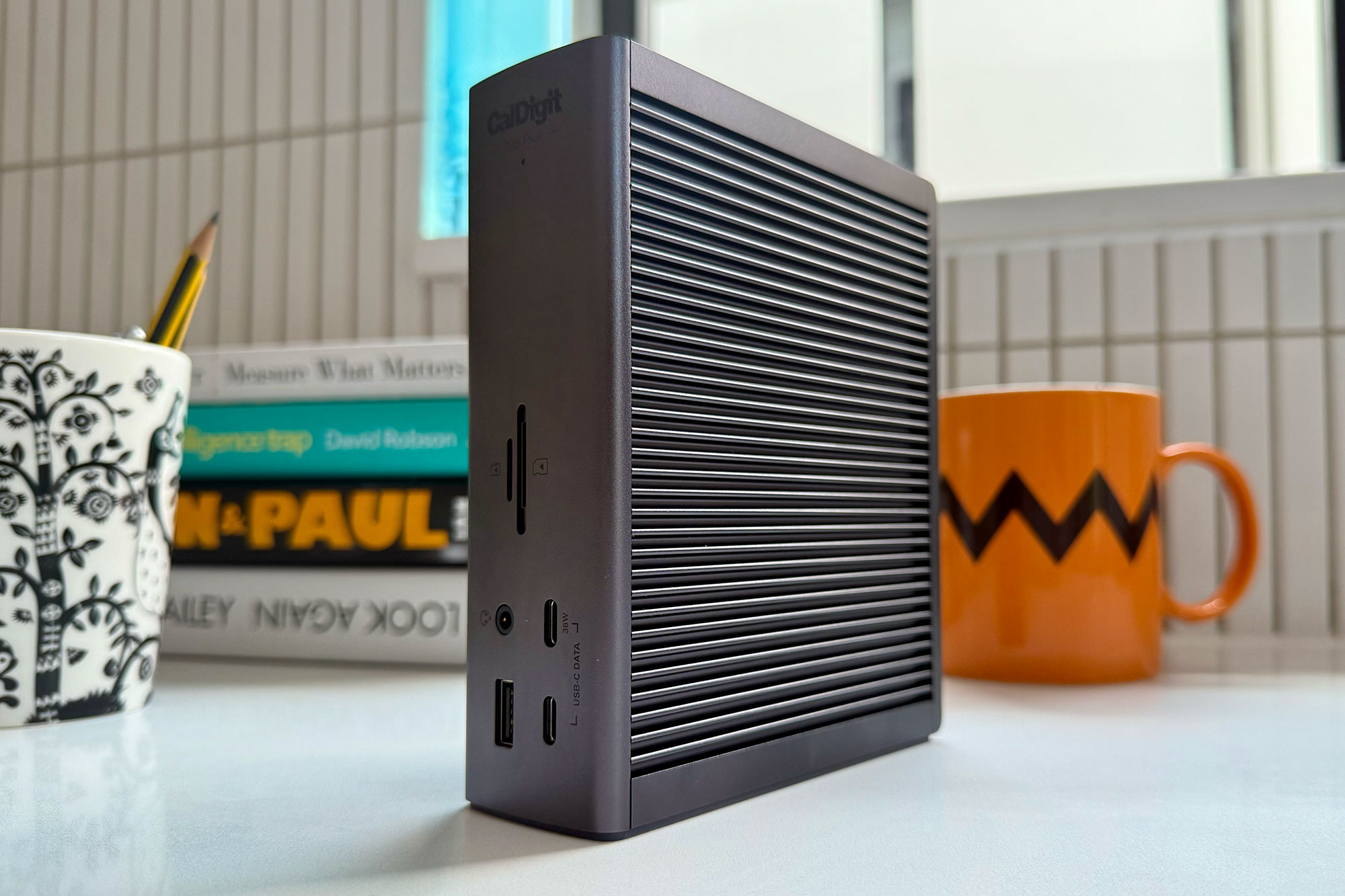
Pros
- Thunderbolt 5
- 20 top-end ports
- 10Gb Ethernet
- Iconic case
- 330W Power Delivery
- 140W PD 3.1 laptop charging
Cons
- Premium price
- Type:80Gbps Thunderbolt 5 Dock
- Ports:20
- Power:140W PD 3.1; 330W max
- External displays:Up to 2x 8K at 60Hz or 1x 8K at 60Hz
If you desire the ultimate in MacBook docking stations, the CalDigit TS5 Plus has just about everything you need—indeed probably more than you need. Alongside super-fast Thunderbolt 5 you get an unmatched number of top-end ports including 10Gb Ethernet and an incredible 330W power supply.
Somehow CalDigit has included an incredible clearly labelled 20 ports into the compact dock—all of which can be used simultaneously—including ten 10Gbps USB ports (five USB-C and five USB-A), the fastest Ethernet available, top-rated card readers and audio ports front and back. There are three 80Gbps Thunderbolt 5 ports: one upstream to connect to your computer and two downstream for speedy data-transfer devices.
CalDigit has sacrificed a possible third downstream TB5 port for a dedicated DisplayPort in the knowledge that most dock users run at least one external display and so the extra TB5 port would be used for a monitor connection anyway. Depending on the display capabilities of your MacBook, the maximum resolution is 8K at a 60Hz refresh rate, with a possible refresh rate of 240Hz for 4K or 500Hz for 1080p HD.
The TS5 Plus is the first dock with dual 10Gbps USB controllers, one controller for the front ports and one for the ports at the back of the dock for increased USB bandwidth. Each of the USB ports offers 7.5W of power except the front-facing 36W USB-C port. The two downstream Thunderbolt 5 ports also offer 36W. As it has the highest power supply of any dock tested here (330W), all can output at a maximum at the same time—something that’s not possible with most other docks.
- One upstream Thunderbolt 5 port(80Gbps, 140W)
- Two downstream Thunderbolt 5 ports(80Gbps, 36W)
- Five USB-A ports(10Gbps, 7.5W)
- Four USB-C ports(10Gbps, 7.5W)
- One USB-C port(10Gbps, 36W)
- One DisplayPort 2.1
- Ethernet(10Gb)
- UHS-II SD card reader(312MBps)
- UHS-II microSD card reader(312MBps)
- 3.5mm combo audio jack(front)
- Two 3.5mm In/Out audio jacks(back)
- 330W power supply
Who should buy the CalDigit TS5 Plus?
There isn’t a docking station available now that rivals the CalDigit TS5 Plus for number and quality of ports. Each one is rated as high as they go. Priced at $499 in the US (£469 in the UK) it’s significantly more expensive than the Sonnet Echo 13 ($369) and OWC ($329) and Plugable Thunderbolt 5 ($299) docks but none can match the CalDigit TS5 Plus on sheer number and speed of ports and highest-level features. Power users who want the very premium end will pay top dollar for the best. If you can cope with a little less, consider the 15-port CalDigit TS5 reviewed below.
Read our full CalDigit Thunderbolt Station 5 Plus (TS5 Plus) review
Sonnet Echo 13 Thunderbolt 5 SSD Dock – Best Thunderbolt 5 dock for Macs with SSD
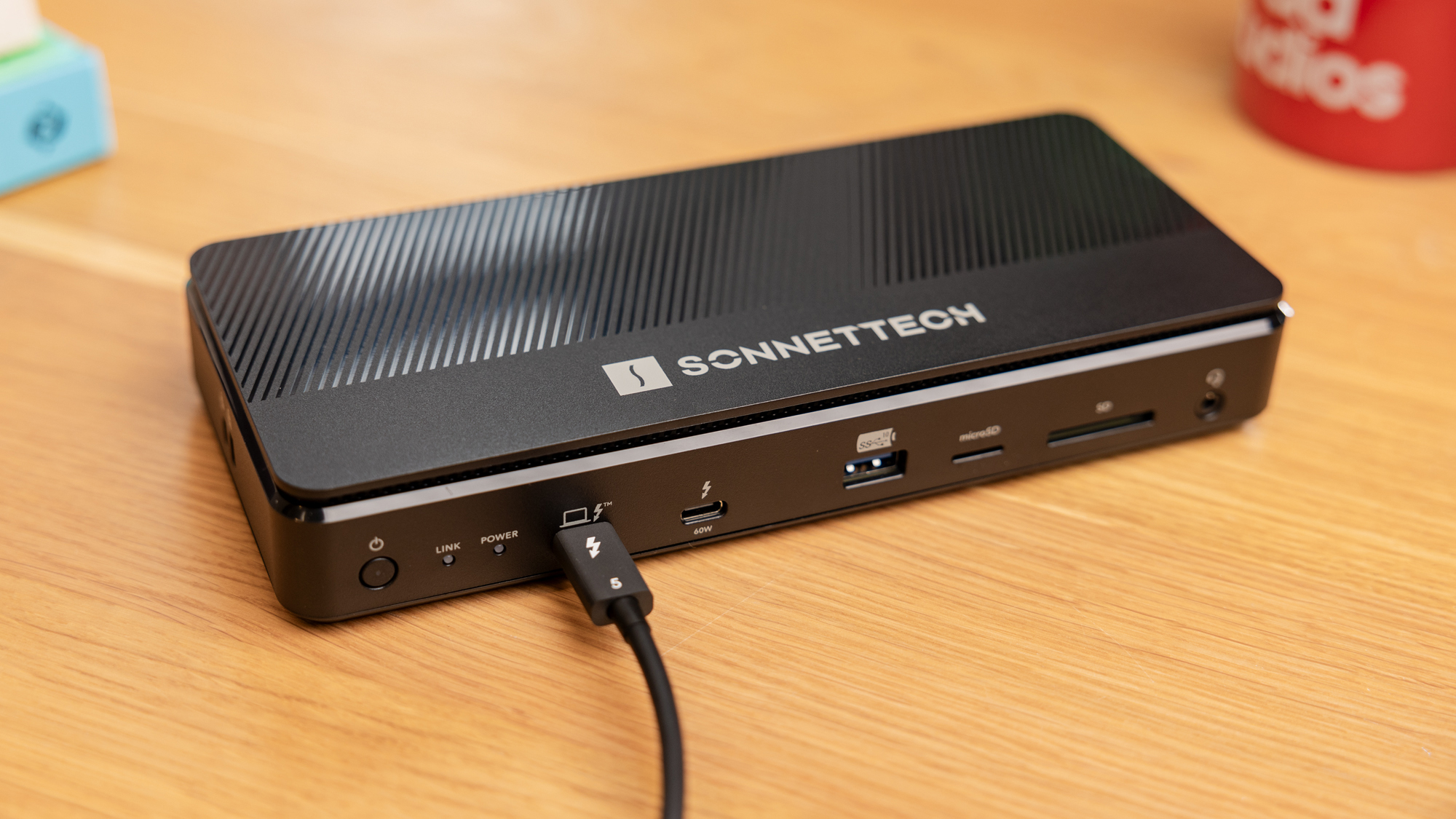
Pros
- Thunderbolt 5
- 12 ports
- Built-in super-fast SSD
- 2.5Gb Ethernet
- Fast card readers
- 140W PD 3.1 laptop charging
- Type:80Gbps Thunderbolt 5 Dock
- Ports:12
- Power:140W PD 3.1; 180W max
- External displays:2x 6K at 60Hz
This Thunderbolt 5 docking station boasts four 80Gbps Thunderbolt 5 ports plus the bonus of integrated internal SSD storage of up to 4TB: choose from 1TB, 2Tb or 4TB..
That internal SSD is installed at purchase and is not user upgradeable, so pushes the price to the high-end of all the docks reviewed here. However, it’s well worth it if you can afford to pay the extra. This internal SSD is super-fast, and in our tests nearly matched the native storage in the Mac itself! Having extra storage that’s so fast will save you money on your next MacBook purchase as Apple’s SSD options cost nearly as much as buying one of these docks by itself.
Sonnet offers port flexibility by not swapping one of the Thunderbolt 5 ports for a dedicated DisplayPort or HDMI video port, as found on the CalDigit TS5 Plus reviewed above. You can attach up to two external 6K displays using either direct Thunderbolt connections to supporting monitors or adding video adapters for DisplayPort or HDMI screens.
If you have the right router, you can take advantage of super-fast wired Internet access with the Echo 13’s 2.5GbE Gigabit Ethernet—2.5x faster than standard Gigabit Ethernet, with which it also works on standard networks.
- One upstream Thunderbolt 5 port (80Gbps, 140W)
- Three downstream Thunderbolt 5 ports (80Gbps, 1x 60W, 2x 15W)
- Two USB-A ports (10Gbps, 7.5W)
- One USB-A port (5Gbps, 7.5W)
- Internal M.2 NVMe SSD (1TB / 2TB / 4TB)
- Ethernet (2.5Gb)
- UHS-II SD card reader (312MBps)
- UHS-II microSD card reader (312MBps)
- 3.5mm combo audio jack (front)
- 180W power supply
Who should buy the Sonnet Echo 13?
This is a top-end solution for owners of Thunderbolt 5 Macs who want to add a range of extra fast ports and super-charge their storage, but owners of Thunderbolt 3 or 4 Macs can future-proof their purchase (as TB5 is backwards compatible with TB4 and TB3) for the same result. Sonnet offers a similar Thunderbolt 4 docking station, the Sonnet Echo 20 Thunderbolt 4 SuperDock (see later in this list), which also offers an internal SSD, but this is optional, user-installed and not as super speedy, and so is more affordable.
Read our full Sonnet Echo 13 Thunderbolt 5 SSD Dock review
Plugable Thunderbolt 5 Docking Station – Best-value Thunderbolt 5 dock
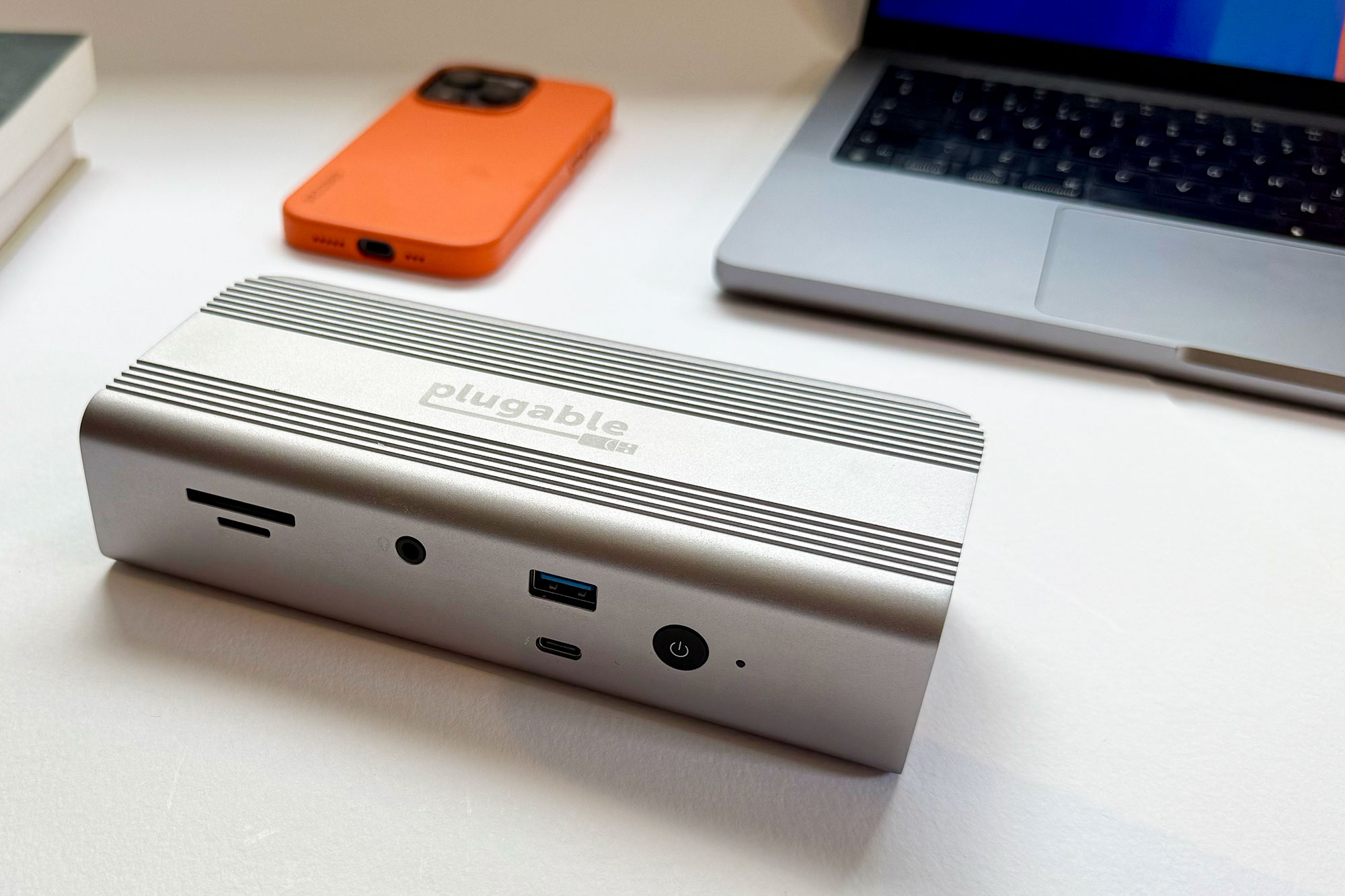
Pros
- Thunderbolt 5
- 11 ports
- 2.5Gb Ethernet
- Fast card readers
- 140W PD 3.1 laptop charging
Cons
- No extra USB-C ports
- North America only
- Type:80Gbps Thunderbolt 5 Dock
- Ports:11
- Power:140W PD 3.1; 180W max
- External displays:2x 6K at 60Hz
While the CalDigit TS5 Plus boasts a mighty 20 ports and 330W of power output and the Sonnet Echo 13 comes with a built-in SSD, this Thunderbolt 5 docking station represents great value by keeping the number of ports to what might be the sweet spot for many users.
The Plugable TBT-UDT3 dock packs four 80Gbps Thunderbolt 5 ports, 2.5Gb Ethernet, fast card readers and a few USB ports. We would have preferred a high-powered USB-C port on the front so you can fast-charge your iPhone while sitting in front of your screens, but then maybe the price would be higher as a result. As it is, it’s the least expensive Thunderbolt 5 dock we have tested so far.
You can attach up to two external 6K displays using one or two of the Thunderbolt ports to USB-C monitors or adding video adapters for DisplayPort or HDMI screens.
- One upstream Thunderbolt 5 port (80Gbps, 140W)
- Three downstream Thunderbolt 5 ports (80Gbps, 15W)
- Two USB-A ports (10Gbps, 4.5W)
- One USB-A port (5Gbps, 7.5W)
- Ethernet (2.5Gb)
- UHS-II SD card reader (312MBps)
- UHS-II microSD card reader (312MBps)
- 3.5mm combo audio jack (front)
- 180W power supply
Who should buy the Plugable Thunderbolt 5 Docking Station?
Other TB5 docks might crow about their many ports or other lust-worthy benefits but if you need a dock to connect a couple of high-res screens and take advantage of Thunderbolt 5’s mega bandwidth plus new network speeds, the Plugable TBT-UDT3 quite likely has you covered for the basics and more.
Read our full Plugable Thunderbolt 5 Docking Station (TBT-UDT3) review
CalDigit TS5 Thunderbolt 5 Dock – The ultimate-lite Thunderbolt 5 dock

Pros
- Thunderbolt 5
- 15 ports
- 2.5Gb Ethernet
- Iconic case
- 330W Power Delivery
- 140W PD 3.1 laptop charging
- Type:80Gbps Thunderbolt 5 Dock
- Ports:15
- Power:140W PD 3.1; 240W max
- External displays:Up to 2x 8K at 60Hz or 1x 8K at 60Hz
The CalDigit TS5 Plus is the ultimate Mac docking station but as we mentioned in its review at the top of this chart, it probably hosts more than you need and is priced accordingly.
Its maker CalDigit therefore also offers a less armed and notably more affordable TS5 model without the Plus at the end of the title. Instead of 20 ports this more compact dock has 15, which is still a lot. It has half as many 10Gbps USB ports but its three USB-C and two USB-A should be enough for most Mac mortals. Its 2.5Gb Ethernet is not as fast as the TS5 Plus’s 10GbE but is still 2.5 times as fast as mere Gigabit Ethernet.
Yet it has the same two top-rated card readers and three audio ports. Indeed its has one more downstream Thunderbolt 5 port than the TS5 Plus that ditched one for a dedicated DisplayPort. The plain TS5’s TB5 ports are rated at the standard 15W of power output compared to the TS5 Plus’s 36W Thunderbolt ports, but it does have a 20W USB-C port at the front for fast iPhone and iPad charging.
- One upstream Thunderbolt 5 port (80Gbps, 140W)
- Three downstream Thunderbolt 5 ports (80Gbps, 15W)
- One USB-C port (10Gbps, 20W)
- Two USB-C ports (10Gbps, 7.5W)
- One USB-A port (10Gbps, 7.5W)
- One USB-A port (480MBps, 7.5W)
- Ethernet (2.5Gb)
- UHS-II SD card reader (312MBps)
- UHS-II microSD card reader (312MBps)
- 3.5mm combo audio jack (front)
- Two 3.5mm In/Out audio jacks (back)
- 240W power supply
Who should buy the CalDigit TS5?
If the $499 TS5 Plus is too over the top for your docking station needs and frankly a little expensive as a result, the cut-down but still impressive $399 CalDigit TS5 could be the more affordable choice that offers everything you need. The Plugable Thunderbolt 5 Dock, reviewed above, knocks a few more ports and can push a little less power to your devices and is another $100 cheaper if you need to cut further.
Read our full CalDigit TS5 Thunderbolt 5 Dock review
Wavlink Thunderbolt 4 Triple Display Docking Station – Best budget Thunderbolt 4 dock
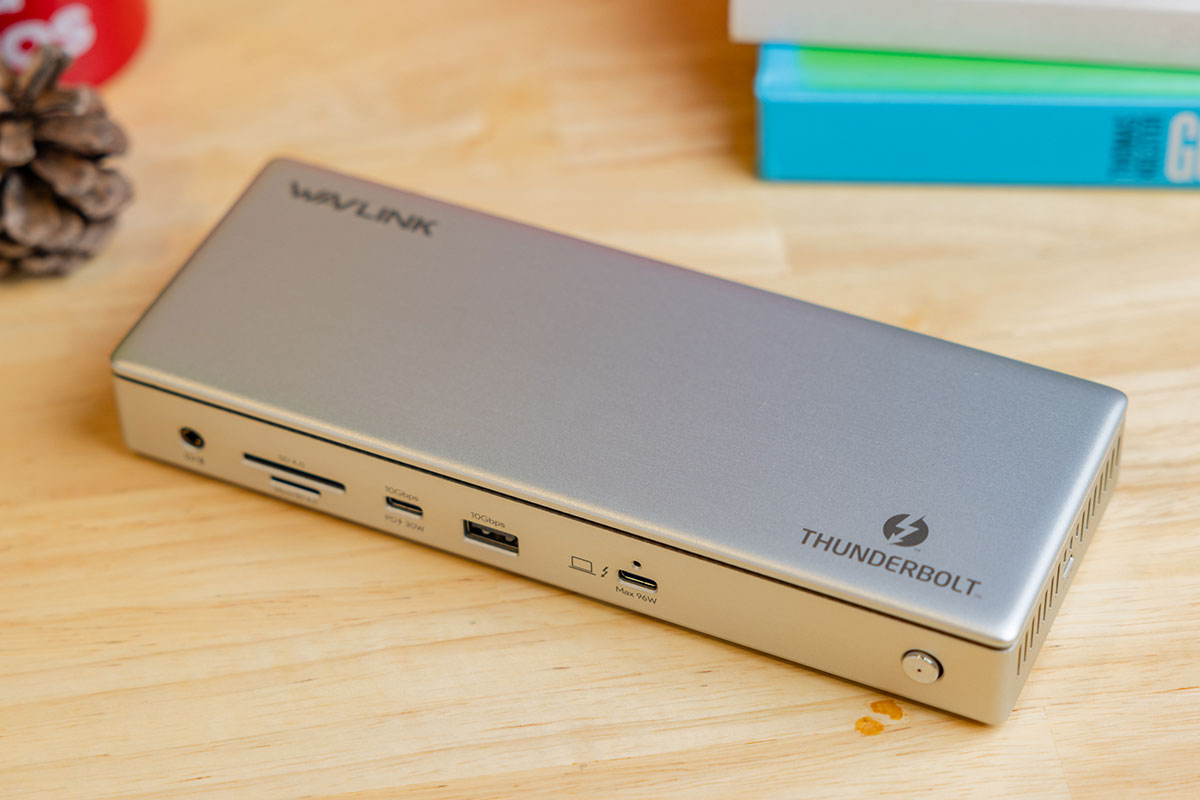
Pros
- Thunderbolt 4
- 13 fast ports
- 2.5Gb Ethernet
- Two HDMI 2.1
- 30W USB-C port
- Affordable
- Type:40Gbps Thunderbolt 4 Dock
- Ports:13
- Power:96W PD 3.0; 160W max
- External displays:2x 4K at 60Hz
The Wavlink Thunderbolt 4 Triple Display Docking station is a bit of a misnomer for Mac users as it can handle only two external 4K displays in Extended Mode on Macs at 60Hz. The third display would just mirror one of the others. That’s a Mac limitation, not one by Wavlink.
That aside, the dock is a well-priced and loaded Thunderbolt 4 dock. It sacrifices two of the potential three downstream TB4 ports in favor of two HDMI 2.1 ports. Use one of these for one external display and the downstream TB4 port for the other. The spare HDMI port would host the mirrored display, or a third extended display on Windows PCs.
The USB ports are fast, as are the two card readers and the backwards-compatible 2.5Gb Ethernet. Thunderbolt 4 allows for 40Gbps data transfer to the laptop.
Power delivery to the laptop is 96W, enough for the 16-inch MacBook Pro. There’s a handy 30W USB-C charging port at the front, which also supports 10Gbps data transfer.
- One upstream Thunderbolt 4 port (40Gbps, 96W)
- One downstream Thunderbolt 4 port (40Gbps, 15W)
- Two HDMI 2.1 video ports (4K at 60Hz)
- One USB-C port (10Gbps, 30W)
- Two USB-A ports (10Gbps, 4.5W)
- Two USB-A ports (5Gbps, 4.5W)
- 2.5Gb Ethernet
- UHS-II SD Card reader (312MBps)
- UHS-II MicroSD Card reader (312MBps)
- 3.5mm audio jack
- 160W power supply
Who should buy the Wavlink Triple Display Dock?
If you want a generous set of extra ports and to connect a couple of 4K displays, this affordable yet able Thunderbolt 4 dock is a great solution even for budget-conscious TB5 Mac users.
Read our full Wavlink Thunderbolt 4 Triple Display Docking Station review
CalDigit Thunderbolt 5 Element 5 Hub – Best Thunderbolt 5 hub / mini-dock
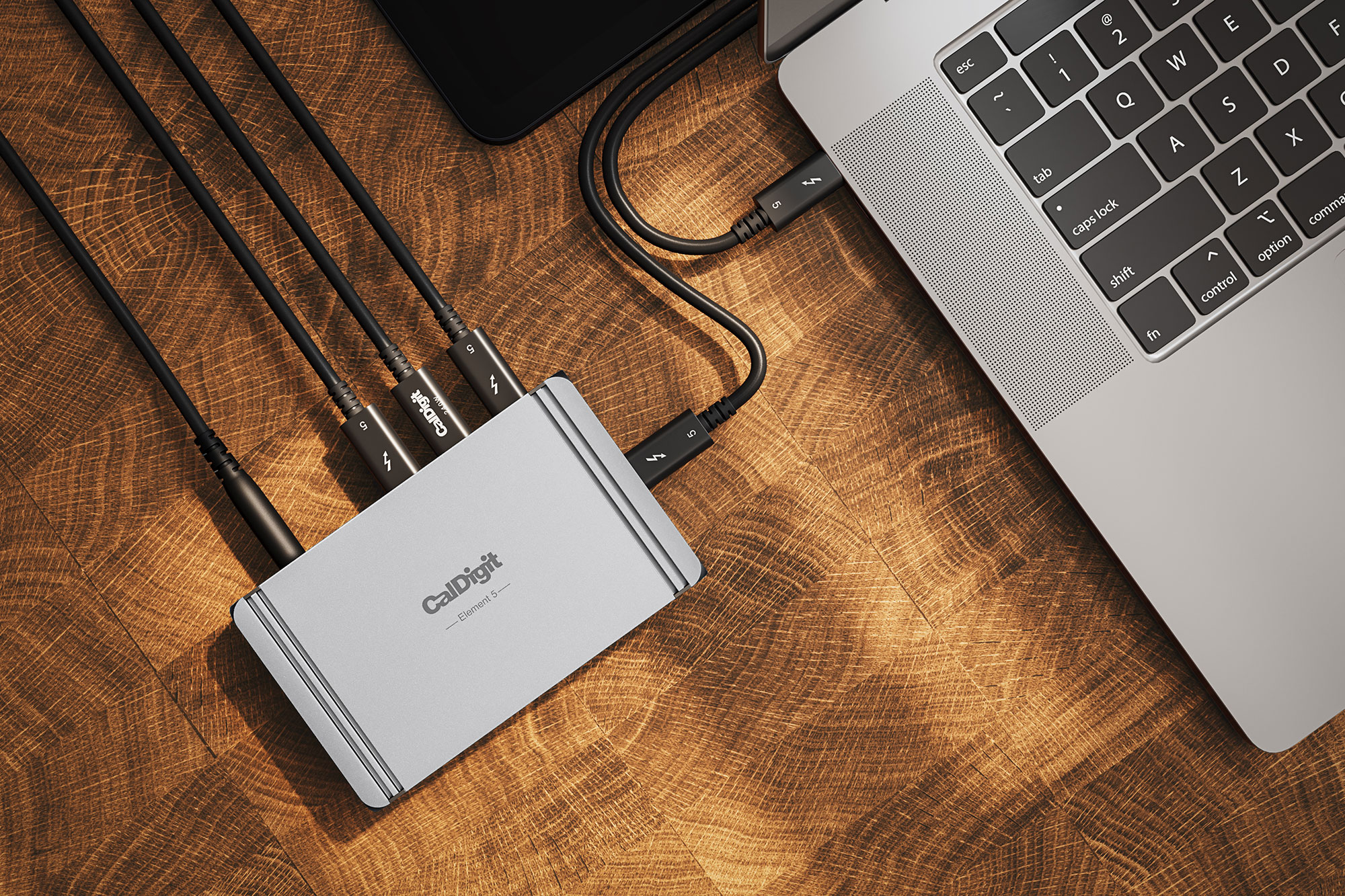
Pros
- 4x Thunderbolt 5
- 2x 10Gbps USB-C
- 3x 10Gbps USB-A
- 180W total power
- Compact
- Type:80Gbps Thunderbolt 5 Hub
- Ports:9
- Power to laptop:90W PD 3.0; 180W max
- External displays:2x 6K at 60Hz; 2x 4K at 240Hz
The CalDigit Thunderbolt 5 Element 5 Hub isn’t a full dock because it doesn’t feature anything other than Thunderbolt and USB ports—no Ethernet, SD card reader or audio port.
But it boasts so many top-end Thunderbolt and USB ports that you can customize it to your every desire. It has one more than its Thunderbolt 4 predecessor, the 8-port Element 4 Hub, reviewed below, and more than the OWC Thunderbolt 5 Hub, also reviewed below, although is priced higher as a result.
There are four TB5 ports (one upstream to your computer placed handily on the side, and three downstream to other devices), two fast 10Gbps USB-C and three 10Gbps USB-A ports.
You can use two of the three downstream TB5 ports to connect directly to USB-C- or Thunderbolt-equipped monitors or HDMI or DisplayPort screens using inexpensive adapters. It can connect to dual 6K/60Hz or dual 4K/240Hz extended displays on Macs.
That still leaves you a spare TB5 port and the five USB ports to add further devices, such as an adapter for Gigabit Ethernet and/or SD card reader, SSDs, memory sticks and so on as your requirements demand, so there is no port wastage.
Its 90W laptop charger is powerful enough for most MacBook charging needs (the OWC Hub boasts a 140W PD), and beats the Element 4’s rather underpowered 60W PD. Its 180W power supply is also generous for what calls itself just a hub.
It’s small enough to be portable, and its external power supply is also pretty dinky.
- One upstream Thunderbolt 5 port (80Gbps/120Gbps, 90W)
- Three downstream Thunderbolt 5 ports (80Gbps, 15W)
- Two USB-C ports (10Gbps, 7.5W)
- Three USB-A ports(10Gbps, 7.5W)
- 180W power supply
Who should buy the CalDigit Element 5 Hub?
This is the most compact Thunderbolt 5 port replicator. As a hub it doesn’t offer the variety of port types you find on a dock but it has nine TB/USB that can (with the right adapters) handle anything you need.
Read our full CalDigit Thunderbolt 5 Element 5 Hub review
OWC Thunderbolt 5 Dock – Best budget Thunderbolt 5 dock
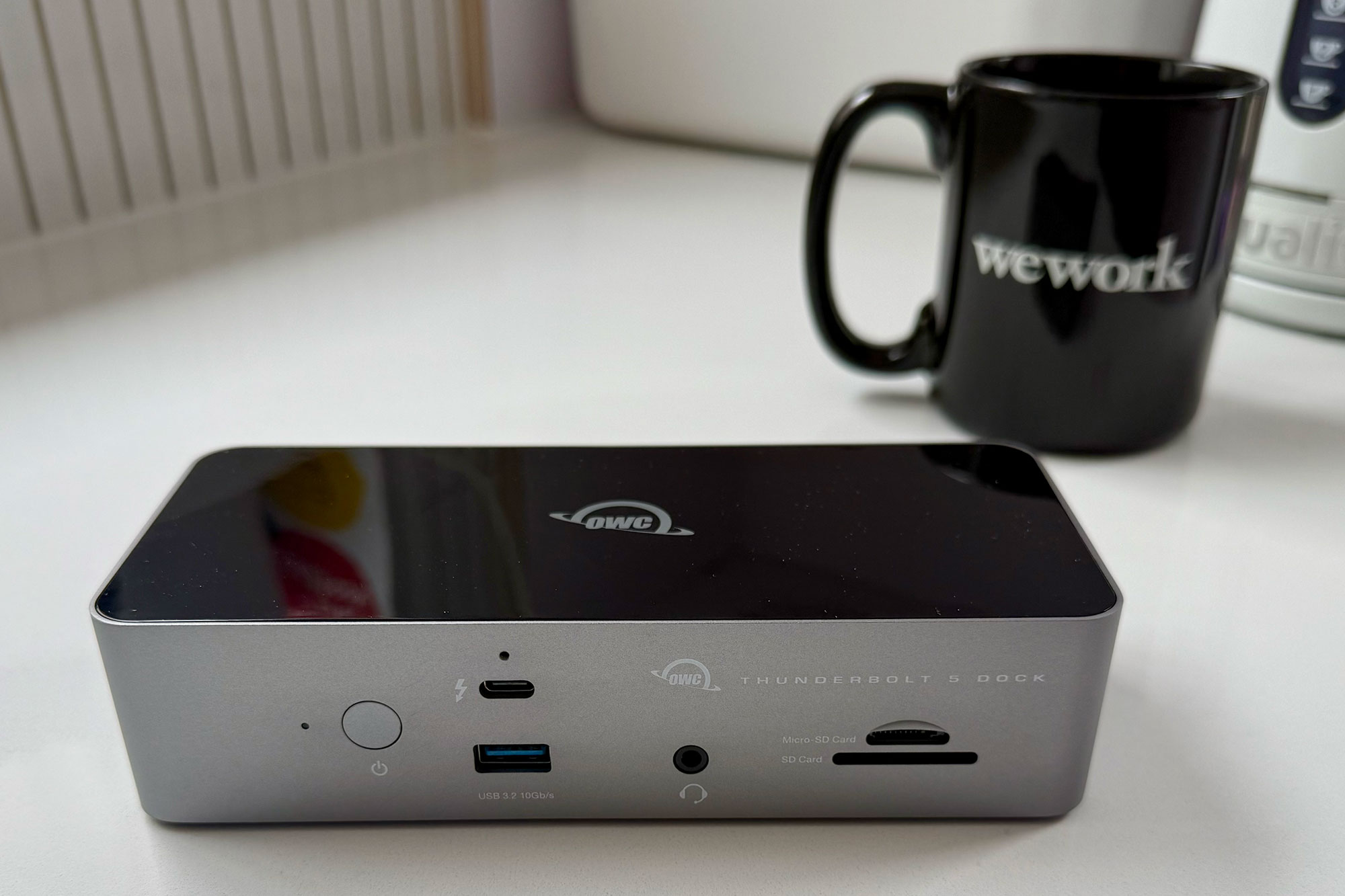
Pros
- Thunderbolt 5
- 11 ports
- 2.5Gb Ethernet
- Fast card readers
- 140W PD 3.1 laptop charging
Cons
- No extra USB-C ports
- Type:80Gbps Thunderbolt 5 Dock
- Ports:11
- Power:140W PD 3.1; 180W max
- External displays:Up to 2x 6K at 60Hz
While the CalDigit TS5 Plus boasts 20 ports and super power output and the Sonnet Echo 13 includes an integrated SSD, this Thunderbolt 5 dock offers the basics any modern TB5 docking station should carry: four 80Gbps Thunderbolt 5 ports, 2.5Gb Ethernet, fast card readers and a few USB ports.
There’s no dedicated video port as OWC gives you the flexibility to chose how you want to use the three downstream TB5 ports rather than sacrifice one for a DisplayPort or HDMI.
There are three USB ports but all are legacy Type A, leaving the Thunderbolt ports to be your Type C options. Thunderbolt is a very able type of USB-C but rated at just 15W for power output it’s not capable of being used to fast charge an iPhone, which Apple states requires at least 18W. Other docks include at least a 20W USB-C port for that purpose.
- One upstream Thunderbolt 5 port (80Gbps, 140W)
- Three downstream Thunderbolt 5 ports (80Gbps, 15W)
- Two USB-A ports (10Gbps, 7.5W)
- One USB-A port (5Gbps, 7.5W)
- Ethernet (2.5Gb)
- UHS-II SD card reader (312MBps)
- UHS-II microSD card reader (312MBps)
- 3.5mm combo audio jack (front)
- 180W power supply
Who should buy the OWC Thunderbolt 5 Dock?
Other than the lack of fast-charging USB-C port, the OWC Thunderbolt 5 Dock has a useful set of ports including four Thunderbolt ports and fast Ethernet. At a reasonable price it may offer just what you need without throwing in extras you don’t require.
Read our full OWC Thunderbolt 5 Dock review
Anker Prime 14-in-1 Thunderbolt 5 Docking Station – Stylish Thunderbolt 5 dock
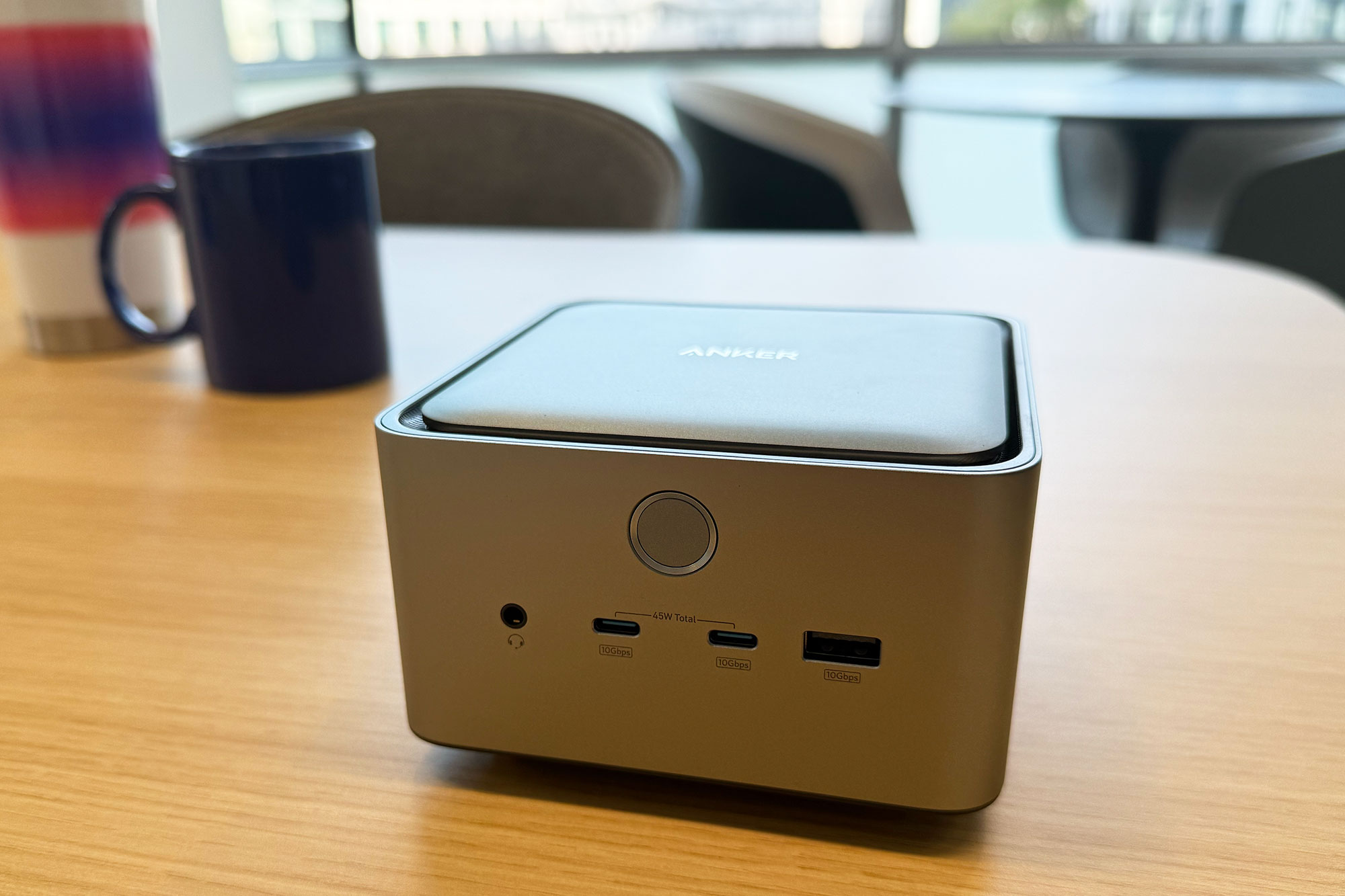
Pros
- 14 top-end ports, including three Thunderbolt 5
- 2.5Gb Ethernet
- 140W Power Delivery
- Stylish looks complement Mac mini and Studio
Cons
- Slow card readers
- Type:80Gbps Thunderbolt 5 Dock
- Ports:14
- Power:140W PD 3.1; 232W max
- External displays:Up to 2x 6K at 60Hz
Apple has always been fond of a square and stylish desktop designs, from the original Macintosh through the G4 Cube and all the way to the latest M4 Mac mini. Yet, accessories such as docking stations that are meant to sit next to these Macs are usually either tall and thin or long and slim. The Anker Prime 14-in-1 Thunderbolt 5 Docking Station looks rather like the latest Mac mini and Mac Studio with the same aluminum finish and port arrangements. It measures 4.6 x 4.6 x 3.0 inches; the M4 Mac mini, 5 x 5 x 2 inches.
While the M4 mini uses Thunderbolt 5, this compact dock is aimed more at the latest TB5-packing MacBooks, which lack as many ports and will link to the dock’s array via a single TB5 cable connection.
Anker could have included three downstream Thunderbolt 5 ports but has chosen to offer a choice of dedicated video ports, either top-end HDMI 2.1 or DisplayPort 2.1. These are helpful if your monitors require one of these connections rather than a direct USB-C or Thunderbolt monitor connection. Dropping the potential third downstream TB5 port for dedicated video ports is convenient for some users—those with HDMI or DisplayPort monitors—but less flexible for those with USB-C or Thunderbolt monitors.
Other docks include faster UHS-II card readers that support speeds of 312MBps, so Anker has cut a corner here in comparison. That said, the card readers work well for users who just want to add inexpensive storage to their setup.
- One upstream Thunderbolt 5 port (80Gbps, 140W)
- Two downstream Thunderbolt 5 ports (80Gbps, 15W)
- One HDMI 2.1 port
- One DisplayPort 2.1 port
- Three USB-A ports (10Gbps, 1x 7.5W, 2x 4.5W)
- Two USB-C ports (10Gbps, share 45W)
- Ethernet (2.5Gb)
- SD card reader (UHS-I, 104MBps)
- microSD card reader (UHS-I, 104MBps)
- 3.5mm combo audio jack (front)
- 232W power supply
Who should buy the Anker Prime 14-in-1 Thunderbolt 5 Dock?
The Anker Prime 14-in-1 TB5 Docking Station is a powerful dock that’s built for the new class of Thunderbolt 5 Macs and will add Apple-like grace and style to your desk space. It has a wide range of well-placed fast ports. Price is at the high-end but if its looks appeal you can rest assured that the quality is high.
Read our full Anker Prime 14-in-1 Thunderbolt 5 Docking Station review







